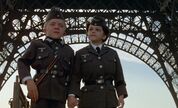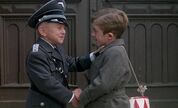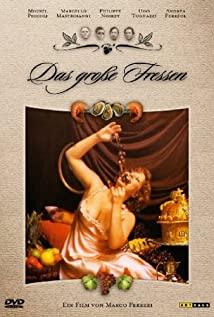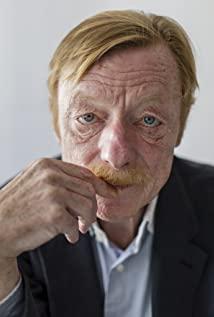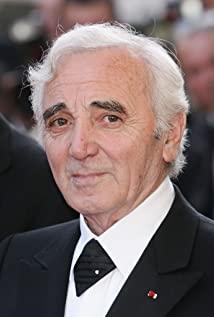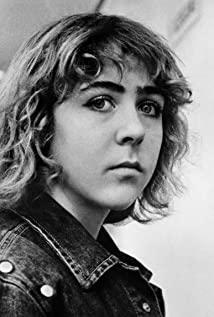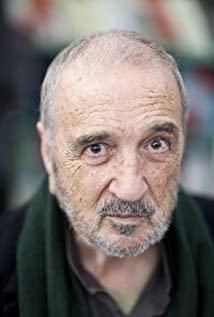The following is what I listened to and recorded from the podcast "Dai Jinhua's Film Lesson". It is a record of knowledge points for me, about the director's position, about the shooting technique, about the history of World War II and its reflection. To share with those in need, the imagery is rich and the understanding is multiple, but it is beneficial to open the book.
dark adult fairy tale
Schlöndorff is one of the most important directors of the new German film era, along with Wenders and Fassbender. He is not as famous as Wenders in the field of art film, nor like Fassbender. As shocking as the world is, he is a very persistent director, and The Tin Drum made him world-famous and a film that is widely watched and continues to be discussed because it was Considered an important film that deeply reflects on Nazi fascism.
It is different from most of the films that directly show the atrocities of Nazi and fascism. It does not directly show the rise of the Third Reich or the atrocities such as anti-Semitism and anti-Semitism. Instead, it adopts a very peculiar angle. We can call it a dark adult fairy tale. It's a fairytale-like tale that chooses a peculiar dwarf protagonist, not so much a dwarf as a surreal protagonist, because at the age of three he decides he won't grow up anymore. If we exaggerate a little and say in the language of web novels, he is a character "born to know", because the protagonist of the story is already looking out from his mother's womb. Then the whole process of his being conceived and born is unfolded in the protagonist's point of view lens. And in the subjective central position of the protagonist he has learned that when he is three years old he will get a tin drum, and he has decided that at three years old he will decide his own life. He did make that decision and he stopped growing up.
So this is an extremely dark adult fairy tale. It is based on a three-year-old, extremely mature, and extremely critical and reflective character setting to unfold the story of the Third Reich. This is the first very interesting feature of the film, and another very interesting feature of the film is that the three-year-old protagonist determines the point of view of the film - a child's point of view, a bottom-up point of view. We noticed that in the film, under the skirts, under the dining table, under the stage of the fascist mass gathering, from below, from the shadowed, invisible dark space to watch the world above, watch the various performances on the open stage , and a view of the dark, dirty, sordid, untold facts that lie beneath the glossy performances.
Probably the thing that will hinder the acceptance of the film is the setting of geospatial in the original novel and film, and this setting naturally carries the basis of political allegory. The story chooses the city of Danzig in today's Poland. Danzig was once an area that was independent and then annexed by Germany on the eve of the outbreak of World War II. At the intersection of the German and Polish borders, Germans and Polish people live together. He marked the geographic space of the historical process of World War II with such attribution in World War II, and used a spatial choice with a very complex European political history to carry the meaning of the political allegory that the film tries to convey. In other words, he uses such a space where Poles and Germans live together to stimulate and remind the possibility of reflection - about the Nazi Third Reich, about the racial narrative of the sublime Germanic people and the lowly Polish peoples At the same time, he also uses this space to endow the whole story, characters, character relationships, characters and narrative itself with ambiguity. The ambiguity of character relationships is used to set off the ambiguity of history, which has been expressed with extreme clarity by mainstream narratives in various historical passages. A space like Danzig City is German or Polish, representing a noble and pure nation or a humble barbarian nation. At the same time, this space corresponds to the identity of Oscar in the story, which is the ambiguous relationship between mother and two men. Oscar and two fathers.
We can never really tell which man's child the Oscar in the story is, the movie will remind us that he has blue eyes like his cousin, or that he has so-called Germanic features like his German father. Such an ambiguous identity, such a filthy incestuous or adulterous relationship corresponds to the city of Danzig, corresponds to the European history during World War II, and corresponds to ordinary people in the European history of World War II.
We can say that this film won the Oscar for best foreign language film and won many international reputations. It was a well-received and popular film at the time because it had a clear and clear theme of historical reflection, and at the same time it had an extremely peculiar original shape. The sequence, that is, Oscar, who decided not to grow up at the age of three, the peculiar world landscape formed by his point of view, a peculiar and absurd performance of the adult world.
Of course, what is more important is that I have repeatedly shared a basic point of view with you in many films. For a film, what is a good film is whether it finds a cinematic way to tell the story. Even among my aesthetic tastes, I am more concerned about whether the narrative method of a film simultaneously becomes an attempt to explore the film itself and the language of the film, or to reflect on self-referentiality. The so-called self-referral is the return of the film. Pointing to the film medium itself, the film returns to tell the story of the film. In this film, we all realize from the beginning that this is a film with the characteristics of reflective self-referential or "meta-film", and from the beginning he uses the paragraph in the history of film that people have absolutely no longer The film special effects used in the silent film era, he used circles and slides, that is, a ring lights up from the center and then opens, or the picture quickly darkens from all sides and finally disappears in the center of the picture. He uses such an old style. Film language, to form a self-reference to the film, and at the same time form a sense of comedy, a sense of comic humor, he used this film form to tell us from the first minute that it was a fairy tale. But of course when such a form is combined with another important modeling sequence in the film or the choice of film language, he tells us that this is not only a fairy tale, but also a dark talk.
Then another important set of modeling sequences I mentioned is the picture style of the film and the color style of the film. You can easily identify such a feature when you watch this film today. He is very consciously looking for a dark tone. The low-light illumination uses a lot of cool color blocks in the picture with warm tones as the main tone. Everyone recalls the story of grandmother at the beginning of the film, the story of the encounter between grandmother and grandfather, the brown tone became the keynote of the picture, but At the same time, a large area of green in the field is covered by brown, this cool tone still makes the warm tone appear a kind of low and dark, so some people say that Schlondorf used "Rembrandt" in this film In fact, it can be said that he used such a feature of Dutch peasant paintings or village style paintings in the fifteenth and sixteenth centuries. When a special paragraph composition of an ancient art history is combined with a memory of a comical film history, such as circle slip, he is clearly conveying to us the characteristics of the adult fairy tale of the film. In the sense of such an adult fairy tale, unfolding the story of the film, unfolding the film with a sense of absurdity, with a peculiar charm, and this charm is disgusting. Put together to form the unique artistic expression of this film.
Another very important feature in this film is that the body becomes a very prominent presence. Everyone has noticed that there are a lot of images of eating, excretion and sex in the film. It is such a powerful physicality, or expressed in Chinese. For "Stinky Skin", the combination of a stinky existence and the subjective point of view of a character who refuses to grow up at the age of three highlights the basic narrative features of the film's adult fairy tale.
Probably the most nauseating scene in the film is the scene where the rotting bull head is used as bait to catch the moray eel, where the moray burrows and gets caught, and then, with almost no transition at all, it serves as a dish When it is brought to the table, the strong sense of absurdity and darkness is formed, and at the same time, it directly touches and stimulates the senses and the body, and such a scene also links the seamless combination of Oscar's legal father and fascism. , and such a combination is a turning point in the fate of a Danzig, a Danzig whose geographical space and political affiliation are extremely ambiguous, because we see Oscar's legal father is so identified from the beginning Fascism, but at the same time it clearly shows us that it is not so much an identity as a vulgarity, that is, if another ism is in vogue at this time, he will embrace it with the same enthusiasm , as long as this doctrine occupies the mainstream position. Then such a character makes a hint with the moray, and he forces his wife to eat the moray until the mother resists, and then accepts it, and eventually she becomes a mentally ill patient who is addicted to fish. die". Such historical fate has become an important historical clue of the film, as well as an important visual feature of the film, that is, the presence of the body, the metaphor of the body, and the suggestive, allegorical and fairy tale characteristics expressed by the visual presentation formed by the metaphor of the body .
family history under the skirt
The tin drum has become a consistent prop in the movie and has become a very important modelling support. The tin drum is directly connected with the Jewish owner of the toy store, with the mother's adultery, with the toy store owner's desperate love for his mother, and with The narrative position formed by Oscar's unique modeling image. He's the evil high-mature all-seeing, all-seeing peeping eye, and he's still a weak three-year-old, so he's going to be bullied by the kids, and throughout the film, one side is The allegorized history, on the one hand, is the worldly life of the extremely naked and realistic flesh, so the whole film has a kind of deliberate nudity and vulgarity, and this deliberate nudity and vulgarity are compared with a kind of classical When the oil painting-style color, lighting and composition are linked together, it forms another extreme encounter in the picture style of the film, which is always formed between the collision of two extremely discordant aesthetics and formal plots. The visual impact and narrative features of the film.
After witnessing the filth and hypocrisy of adult society under the dining table, Oscar decided not to grow up. At the end of the story, the narration appeared "Oscar, should you, should you grow up", and then he fell to the grave again and started grow up. Falling into the grave and growing up This is an important fable that has been discussed and solved by countless film critics. It is about the death of the Third Reich, about the post-war Germany and the Germans trying to grow up. This is the core fable in the film, Oscar A clearer reference to the Third Reich, to Germany and the Germans under the Third Reich, a history that began to choose to refuse to grow up trying to escape the filth and hypocrisy to the point of having to directly bear the impact of war, crimes, atrocities and The heavy price paid by the war, and then decided to grow up. This is the most important support for the so-called reflection on Germany, that is, in this story we see that the original novel and its adaptation did not attempt to simply establish a clear meaning expression, when different nations experienced a cataclysmic historical tragedy. After the history, whether people consciously or not, whether people like it or not, some kind of heavy historical reflection will appear, but at some point people often refuse to reflect in the name of reflection, and this is said because when people claim that we At the beginning of historical reflection, people are just carrying out all kinds of self-litigation and self-justification. In other words, in the name of historical reflection, there is a certain shirk of historical guilt, a kind of self-purification, just like the most famous Nazi. German soldiers or even SS defenses, "I was ordered", or "I was deceived", "I was used" or "I could not", and in this novel and film, it is very important that it shows Oscar's choice, about refusing to grow up, was once a resistance, but soon it became an escape. We then see in the film that his escape still pays a painful price, that is, he must face the brutal world with the body and reality of a three-year-old child, experiencing real violence and extreme helplessness.
But it is very important that the film then set up the dwarf actors in the circus, set up the encounter between Oscar and them, set up Oscar's final joining of them, set up the labor performance that Oscar participated in after joining them, in other words, The protagonist who refuses to grow up to escape history actually ends up in the center of history, in the center of the historical stage, as an active actor on the stage, and at the end of the story he is dressed as a veteran of some kind The uniform returned to the city of Danzig, where the attribution was unclear after the defeat. At this time, history once again caught up with him, that is, he was lately pursued by the eugenic method of race preference as a dwarf, as a weirdo, and it was Su army occupation, he must experience the violence of the occupation army as a poor man in the occupied area. Interestingly a dark allegory, an extremely grotesque tale but at the same time a historical reflection with full sincerity, he makes a surreal character like Oscar experience the inevitable price of any choice, and The original intention of this choice may lead them to a historical end that completely deviates from this original intention. This is an important reason why the film has received high acclaim and received extremely rich and multiple discussions. It is not just a story about a successful escape from history, but more importantly, it shows that no matter how we choose, history is inescapable. In the big era, everyone must face history and make their own choices.
Going back to the beginning and end of the story, we will see another dark and dark tone that runs through the film, that is, the story begins with a Rembrandt-esque picture, starting with a pre-modern European village scene, We see the young grandmother harvesting potatoes at the beginning of the story, and at the end of the story, the refugee's car is driving on the road and the aging grandmother is still harvesting potatoes in the fields in the embers of the campfire. This kind of tone is a kind of historical at the same time It is the keynote outside of history, about the survival at the bottom, about ordinary survival, about the tenacious and flexible theme of continuing life and continuing history under the violence of history. Such a tone runs through the film, but it is constantly interrupted by all sorts of absurd, ferocious, naked and vulgar images, because the country-style painting scenes shown with the music and the soothing camera telephoto are very About to be interrupted by the intrusion of that funny deserter, my grandfather, so there is the beginning of the family history under the skirt, a very ironic and intensely sensual scene begins this Oscar retrospective. The family history, that is, in this family history, funny silent film techniques such as circle or slide appeared soon, and it was also used such silent film methods to show funny silent film scenes, about family legends, about that How the apparently shot deserter's grandfather made a fortune in America and how he did the matches and insurance business, the direct irony and comedy is self-evident, because he was an arsonist, an arsonist who did a match dealer and insurance business, On the one hand it's a complete extreme encounter and all the elements in the movie are the same, but on the other hand we can probably move the story forward with humor, that there is no more profitable business than an arsonist's insurance business, you You can go to arson first, and then work on compensation for the fire.
So I say the whole movie runs through it with a soothing tone with a tone that seems to be historically violent, like the whole history is changed but some things can't be changed, but it doesn't stay in the slightest that history is just violent Passing by, but life is still the same. Humans are still the same as society. Of course, this is not Schlondorf's basic social concept and social position, because as the standard-bearer of German new films, he is not as radical as Fassbinder, but Compared with Fassbender and Wenders, he is a more political director, so he will not return to that kind of emotion about the world. After the mad clamor, the degeneration of the whole society, and the unprecedented killing in the history of human civilization, the fate of the people at the bottom has not been touched or changed, and society and history are still supported by them, just like the beginning of the story and the The grandmother at the end of the story, like a character who has traveled through and carried the entire history, her destiny continues, and it is through them that our history continues.
This film appeared in West Germany during the Cold War, and it was so widely welcomed in the entire European and American society during the Cold War. It is still a reflection on Nazism. The questioning of Nazism was a common theme across the world as it crossed the Cold War divide during World War II. Because the rise of Nazi reflexivism is so powerful and great that it is so powerful and great that no one can shy away from it. In a sense, all literature and art during World War II are related to the history of World War II in some way, but the uniqueness of "The Tin Drum" is that it has found a successful path to break through the war reflection and Cold War during World War II. The dilemma between the political-historical structures of the era, because I think the scariest thing about Nazi fascism is like a thriller, it's not a horror movie, it's not an alien demon, it's not an evil political force falling from the sky, violently It breaks our ordinary daily life, destroys our life and almost destroys the world, but it is because Nazi fascism is legitimately produced in the social and political system of the contemporary West, the ordinary and ordinary, in other words, fascism The nightmares and shadows of racism and racism are inherent in modern civilization, in the modern democratic system, and in the hearts of modern citizens. Every fascist was a good citizen before they became a fascist gangster, like Oscar's legal father, so the story is that Oscar's two fathers have two different personalities, two different choices, two different Different racial identities and racial identities, but none of them can escape the fate of being destroyed by the atrocities of the war. When they were all destroyed by the war, Oscar had to decide to grow up, so he reminded us of fascism in this way The threat of fascism, his reflections on fascism provide an effective way of showing, and at the same time provide a deeper allegorical meaning for us to find its inner threat in fascism and be wary of its comeback.
View more about The Tin Drum reviews



